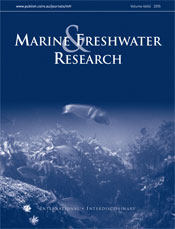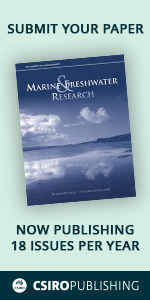Marine and Freshwater Research
Volume 66
Number 4 2015
As many of the world’s shark and ray populations continue to decline there is a growing need for improved conservation and management. One of the key requirements enabling design of effective conservation and management actions is life history parameters as these provide basic information on the dynamics of populations. Life history parameters (e.g. age, growth and reproduction) are directly tied to the reproductive output of a species, and thus unequivocally linked to the capacity of a population to withstand exploitation and to recover from decline. Despite this importance, research on the life history of sharks and rays has declined in recent years as ‘cooler’ and non-lethal topics have become more commonplace. However, on-going research on life history is fundamental for positive action to address declines of shark populations and policies aimed at recovery of populations. To highlight research that has been and is being conducted on the life history of sharks and rays, we have compiled a ‘Shark and ray life history’ virtual issue of Marine and Freshwater Research, which is freely available from the Journal’s website for a limited time.
Relationships between fluctuating hypoxia and sublethal effects on ventilation, feeding and growth of juvenile barramundi, eastern rainbowfish and sooty grunter were investigated in laboratory experiments. Fish were found to be tolerant of fluctuating hypoxia, as they continued to feed and grow under daily exposure to severe treatments for several weeks, although some negative effects were recorded.
Advances in research and technology over the last 20 years have improved the precision and utility of bomb radiocarbon dating in validating the age and growth of fishes. The large and iconic reef fishes chosen for this age validation study exemplifies the current state of the technique by pushing the limits of sample extraction and analysis. Bomb radiocarbon dating can now provide valid estimates of age for fishes that could not be considered previously because of otolith mass limitations.
The effects of sediment resuspension, salinity and temperature on plankton communities of tidally influenced coastal lakes were investigated using feeding experiments and a monitoring study. Moderate levels of turbidity and salinity affected clearance and ingestion rates of Daphnia carinata, heterotrophic nanoflagellates (HNF) and ciliates in the experiments. The monitoring study showed that resuspension, salinity and temperature affect a wide variety of biota.
The reproductive cycle of Arbacia dufresnii was studied in two contrasting populations in Patagonia, Argentina. A. dufresnii showed an annual cycle, with gametogenesis occurring mainly in the autumn and the winter. An extended spawning period occurs during the spring and the summer. Temporal and spatial differences in gonadal cell composition were detected suggesting plasticity in reproductive traits.
Many rivers stop flowing in seasonally dry regions and freshwater communities become dependent on resulting pools of water for survival. We examined the relationship between pool habitat quality and indices of fish health; finding that certain measures were positively correlated with water quality but that results depended upon fish type. Understanding the affect of changing habitat on ecosystem health is important for rural development.
Coastal systems are prone to strong salinity fluctuations over time. Using long-term data (6 years), this study demonstrated that temporally structured environmental variables (salinity and total phosphorus) were important for zooplankton composition, and that the resting egg bank likely plays a minor role in zooplankton colonisation during low-salinity periods.
White Island, north-east New Zealand, is an active volcano, bubbling warm gas into shallow seawater. We measured water and calcified algae near and far from the volcano, and discovered that these vents make seawater both warmer and more acid than the surrounding ocean, thus affecting the strength of skeletons living there. White Island offers a natural laboratory for investigating the effects of future climate on marine organisms and environments.
For satellite-tracked manatees, loss of fine-scale movement data because of satellite tag detachment or functionality problems is common. We supplemented manatee satellite-tracking data by using moored datalogging hydrophones deployed at strategic locations throughout our study area to detect the belt acoustic transmitters that were retained even when satellite tags were lost. Using this approach, we detected five tracked manatees, including three that had lost satellite tags, and concurrently detected other estuarine fauna tagged by local researchers using compatible equipment. The use of moored datalogging hydrophones partially mitigated the loss of satellite-tracking data and enhanced collaborative opportunities with other researchers.
Jungle perch (Kuhlia rupestris) are in decline. Current captive breeding practice involves multiple individuals per tank. We first determined the minimum number of microsatellite loci and larvae required to accurately quantify parental contributions. Not all fish contributed to larval production with a skew towards offspring from one mating pair (average 62%). This has implications for restocking of this species.
Cymothoid isopods include mouth-dwelling fish parasites that can pose threats to fisheries and aquaculture. Here we describe a significant correlation between host size and that of both female and male Ceratothoa italica infecting the striped sea bream Lithognathus mormyrus. We discuss anatomical and behavioural constraints that may explain this association and could represent a framework to understand the adaptive radiation of this family of parasites.




